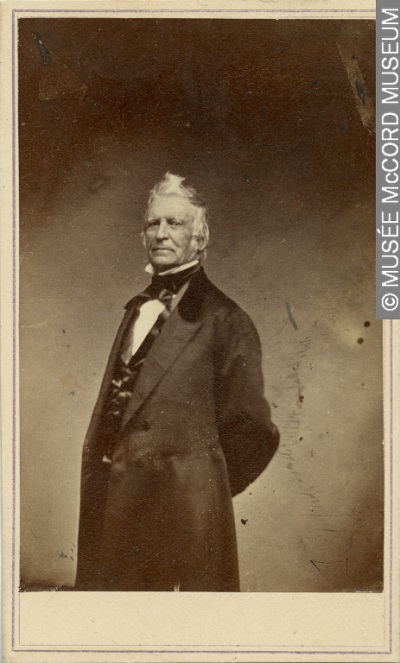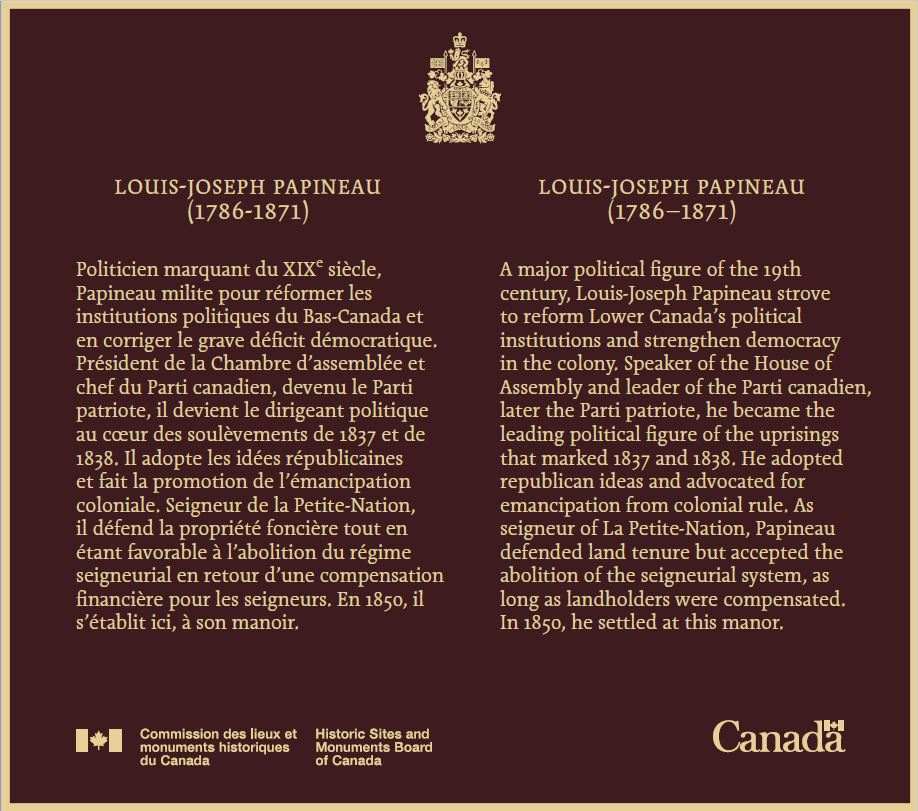Louis-Joseph Papineau National Historic Person (1786-1871)

Louis-Joseph Papineau was designated a national historic person in 1937.
Historical importance: Famous French-Canadian nationalist, seigneur at Montebello.
Commemorative plaque: 500 Notre-Dame Street, Montebello, QuebecFootnote 1
A major political figure of the 19th century, Louis-Joseph Papineau strove to reform Lower Canada’s political institutions and strengthen democracy in the colony. Speaker of the House of Assembly and leader of the Parti canadien, later the Parti patriote, he became the leading political figure of the uprisings that marked 1837 and 1838. He adopted republican ideas and advocated for emancipation from colonial rule. As seigneur of La Petite-Nation, Papineau defended land tenure but accepted the abolition of the seigneurial system, as long as landholders were compensated. In 1850, he settled at this manor.
Louis-Joseph Papineau
A charismatic and eloquent politician, Louis-Joseph Papineau was a major political figure in the 19th century. He served as Speaker of the House of Assembly of Lower Canada from 1815-23 and 1825-37, and led the Parti canadien (later the Parti patriote). During these years, he strove to reform Lower Canada’s political institutions and strengthen democracy in the colony. He became the leading political figure of the uprisings that marked 1837 and 1838, and, with others, drafted the 92 Resolutions of the Patriotes. A proponent of colonial emancipation, he adopted republican ideas and remained committed to preserving the traditions of French Canadians.
The son of Joseph Papineau, a seigneur and member of the House of Assembly, Louis-Joseph was born in Montreal in 1786. Following in his father’s footsteps, he was elected to the House of Assembly of Lower Canada as the member for the county of Kent in 1808 and began serving in 1809. An exceptional orator, he distinguished himself among the young nationalists and became the leader of the Parti canadien, which in 1826 became the Parti patriote. He argued against the legislative union of Upper and Lower Canada, and in 1823 travelled to London as part of a Lower Canada delegation to prevent the adoption of such a measure. He advocated for the reform of Lower Canada’s political institutions, particularly the non-elected legislative council, and worked to paralyze the political system as a means of forcing the British government to give more power to French-Canadian representatives. In 1834, Papineau, Elzéar Bédard, Augustin-Norbert Morin and Louis Bourdages drafted the “92 Resolutions” – a list of the demands and grievances of the Parti patriote. These resolutions called for control of the revenues by the House of Assembly and an accountable and elected Executive Council. The Crown rejected these demands by adopting the Russel Resolutions, stirring up discontent among a part of the population that was struggling with an economic crisis and prompting a confrontation that quickly turned into a revolutionary movement.

The Parti patriote was divided by different strategies shared by the political and military wings. Papineau remained moderate and prudent, limiting his actions to the framework of the constitution. On October 23, 1837, he addressed a rally of 4,000 citizens at Saint-Charles parish. At this gathering, Papineau once again urged the population not to resort to insurrection. The Patriotes issued a declaration of human rights and declared independence of the Six Counties and their willingness to resort to arms. Shortly thereafter, Governor Gosford issued warrants for the arrest of Papineau and the main Patriote leaders. This escalation led to the armed conflicts in the fall of 1837. At the end of November, when the defeat of the Patriotes was imminent, Papineau fled to the United States and then sailed to France in 1839. Amnestied in 1844, he came back to Lower Canada 1845. He settled in the seigneury of Petit Nation, where he devoted himself to the development of his seigneurial estate and the establishment of the seigneurial infrastructure. He returned to politics in 1848, first joining Louis-Hyppolite La Fontaine’s group, but eventually separating from it because of their differences. An ardent republican, he advocated a republican government in a continental union in America. Papineau left politics for good in 1854, and died at his manor house “Monte-Bello” in 1871.
Backgrounder last update: 2022-10-06
Other national historic designations associated with this one:
The National Program of Historical Commemoration relies on the participation of Canadians in the identification of places, events and persons of national historic significance. Any member of the public can nominate a topic for consideration by the Historic Sites and Monuments Board of Canada.
- Date modified :